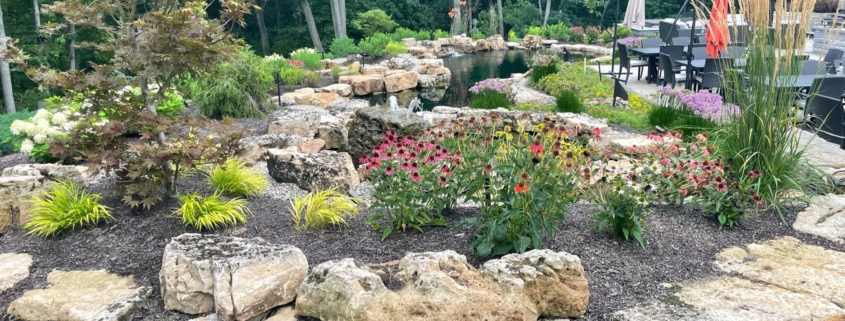7 Reasons to Incorporate Native Plants into Your Landscape
We all want a beautiful landscape surrounding our home; it’s our very own slice of paradise. But what does “beautiful” mean? Is it just aesthetic – or does it prioritize sustainability? Does it encompass adaptability and cost-effective maintenance? Does it mean working with nature instead of, perhaps, against it? And does it mean finding the time to relax and enjoy the view?
Yes!
Beauty is all of this, and one of the single most effective ways to achieve it is to incorporate native plants into your landscape.
7 Reasons to Incorporate Native Plants into Your Landscape
Imagine bright Black Eyed Susan, Blue Flag Iris, Cardinal Flower, Coneflower, Columbine Flower, Nodding Wild Onion, Flowering Dogwood, and Red Maples as far as the eye can see – or at least until your property line. All of these species (and many more) are native to Indiana and provide a variety of benefits:
1. Conserve Water
With drought conditions becoming a norm here in Indiana, saving water is a top priority. Clean water is valuable water, and we need to safeguard this resource. Native plants typically need less water than non-natives. Irrigation is usually unnecessary as these species grow strong, deep root systems that help them store water for long periods.
2. Skip the Fertilizer
Native species have had generations to adapt to their ecosystem. They grew up in rich soil, in poor soil, in dry soil… They have learned how to survive off the nutrients available, so you can save your time and your money. You can also help save your community’s aquatic life (fertilizers pollute storm runoff, and this creates toxic habitats for fish, beneficial bacteria, organisms, plants, etc.) — not to mention the animals that drink from and hunt at these water sources.
3. …And the Pesticide
Because they’ve had so much practice adapting, native species have a natural “immune system” that protects them from insects, fungi, and diseases. As with fertilizer, this greatly reduces your costs and helps the overall community environment.
4. Reduce Invasive Species
Indiana’s invasive species are intruders that can infiltrate your entire landscape – and your neighbors’. They overtake the native plants and dominate; it’s not just a matter of Japanese Honeysuckle or Garlic Mustard kicking the poor Black Eyed Susans out. Invasive species can threaten biodiversity, negatively impact the wildlife/aviary population, and even increase our risk of wildfire. Non-native plants also require more time and money to maintain.
5. Support Biodiversity
In the landscape, everything is interconnected – and every form of life plays a role, from plants and animals to insects, pollinators, fungi, and bacteria. They depend on each other for survival. Native plants provide food, nectar, and shelter for many species.
6. Reduce Runoff and Prevent Erosion
When it rains, the soil soaks up some of the water to replenish moisture levels. Most of it, however, flows into storm drains. It collects fertilizers, pesticides, chemicals, road salt, etc., and pollutes the local waterways. Native plants help capture more rainwater and filter it, reducing the environmental impact of runoff.
Native species can also help prevent erosion in your yard. Their deep root systems anchor the soil. Combined with reduced runoff, you can keep your landscape much more stable.
7. Enjoy Your Landscape
Native plants require far less water, little to no fertilizer, and very little in the way of maintenance. They cost less to grow and nurture, and they are far less demanding of our time. This gives you more time to relax and appreciate your space. What good is a great landscape if you don’t get to enjoy it!
Achieve Your Definition of Beautiful
Whatever your goals, incorporating native plants into your landscape is an effective, efficient, and environmentally friendly way to accomplish them. Not sure what to plant? Or how best to care for your flowers, herbs, shrubs, and trees? Contact GreenImage. We’re here to help – so you can focus on tip #7!



